 Hardly a day goes by when mainstream (or alt) press, facebook or twitter doesn’t report some event, quote or photo that promotes feeling of outrage, sufficient to stir the emotions, galvanising us to share or retweet some sound bite, MEME image or story.
Hardly a day goes by when mainstream (or alt) press, facebook or twitter doesn’t report some event, quote or photo that promotes feeling of outrage, sufficient to stir the emotions, galvanising us to share or retweet some sound bite, MEME image or story.
Whether innocuous or deliberate, wether reported about someone important or someone that wants to be important it matter little. It’s easy to let it trigger our emotions through our basal tribal behaviour (our biology is wired for it) to protest the offence across our modern bastions of information and truth ….social media,. And in that moment there is little intrest in the full story, in a familiar emotion clouds intellect moment. Inevitably the largely good works of public figures over many years are suddenly erased and falling on swords often ensues, ultimately to the detriment of the community.
And as if that isn’t enough cue then the outrage against the outrage and it lives for a least a second media cycle, mean while the big issues of our time hide in the corners ….
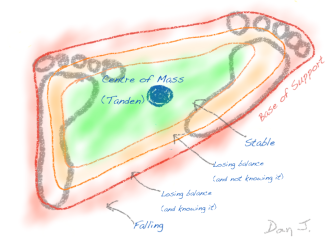
 I just put some Tzigane strings on my violin (rather than my usual Dominant). They are a lower tension string, which I was told would be a bit kinder to my old french violin. In so doing its supposed to bring out its tone a bit better…and how true it was!
I just put some Tzigane strings on my violin (rather than my usual Dominant). They are a lower tension string, which I was told would be a bit kinder to my old french violin. In so doing its supposed to bring out its tone a bit better…and how true it was!
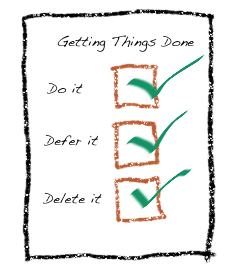 One of my favourite books of all time, in the productivity space is Getting Things Done by David Allen. Its a great read and i was able to take away a few key things that enhanced my ability to get things done! Probably the most important one is his process for looking at emails which can easily become the scourge and time eater of your day, but its also really handy for the short jobs that crop up during the day. If its quick then just Do it on the spot, if its going to take a bit longer then Defer it (but make sure you capture than in some system like flagging it a list or calendar entry or just Delete it. These days with email being what it is I don’t tend to delete , I just let it run off the bottom of the screen..it’s pretty much the same thing.
One of my favourite books of all time, in the productivity space is Getting Things Done by David Allen. Its a great read and i was able to take away a few key things that enhanced my ability to get things done! Probably the most important one is his process for looking at emails which can easily become the scourge and time eater of your day, but its also really handy for the short jobs that crop up during the day. If its quick then just Do it on the spot, if its going to take a bit longer then Defer it (but make sure you capture than in some system like flagging it a list or calendar entry or just Delete it. These days with email being what it is I don’t tend to delete , I just let it run off the bottom of the screen..it’s pretty much the same thing.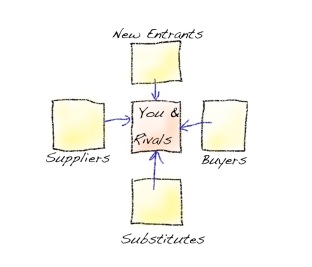 Where ever you are in your business chances are you want to make it a grow a bit or a least make it a bit easier on yourself in the trenches. This is where Porters fives competitive forces can come in really handy. Just by asking yourself these 5 simple questions you can get a better idea of your competitive landscape no matter what kind of business you are running.
Where ever you are in your business chances are you want to make it a grow a bit or a least make it a bit easier on yourself in the trenches. This is where Porters fives competitive forces can come in really handy. Just by asking yourself these 5 simple questions you can get a better idea of your competitive landscape no matter what kind of business you are running.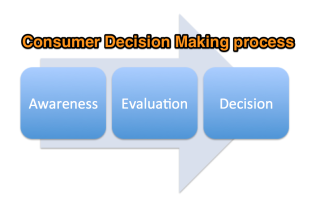 It takes a long time for a prospect to actually make the decision to buy a product or service. There are several processes they go through, and at each step there is a funnelling, or more correctly a loss, of prospects. This is called the consumer decision making process. If you understand your customer you can help them through each of these stages by embedding information and values that will aid a successful conversion.
It takes a long time for a prospect to actually make the decision to buy a product or service. There are several processes they go through, and at each step there is a funnelling, or more correctly a loss, of prospects. This is called the consumer decision making process. If you understand your customer you can help them through each of these stages by embedding information and values that will aid a successful conversion.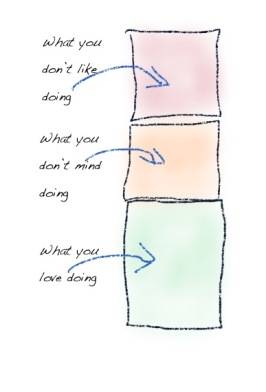 It’s an attractive idea isn’t it?, take something you really enjoy doing and turn it into your career. The trouble is a dream turned into reality can sometime become a nightmare. Somewhere in the process it could also takes away the very thing you love,
It’s an attractive idea isn’t it?, take something you really enjoy doing and turn it into your career. The trouble is a dream turned into reality can sometime become a nightmare. Somewhere in the process it could also takes away the very thing you love,
